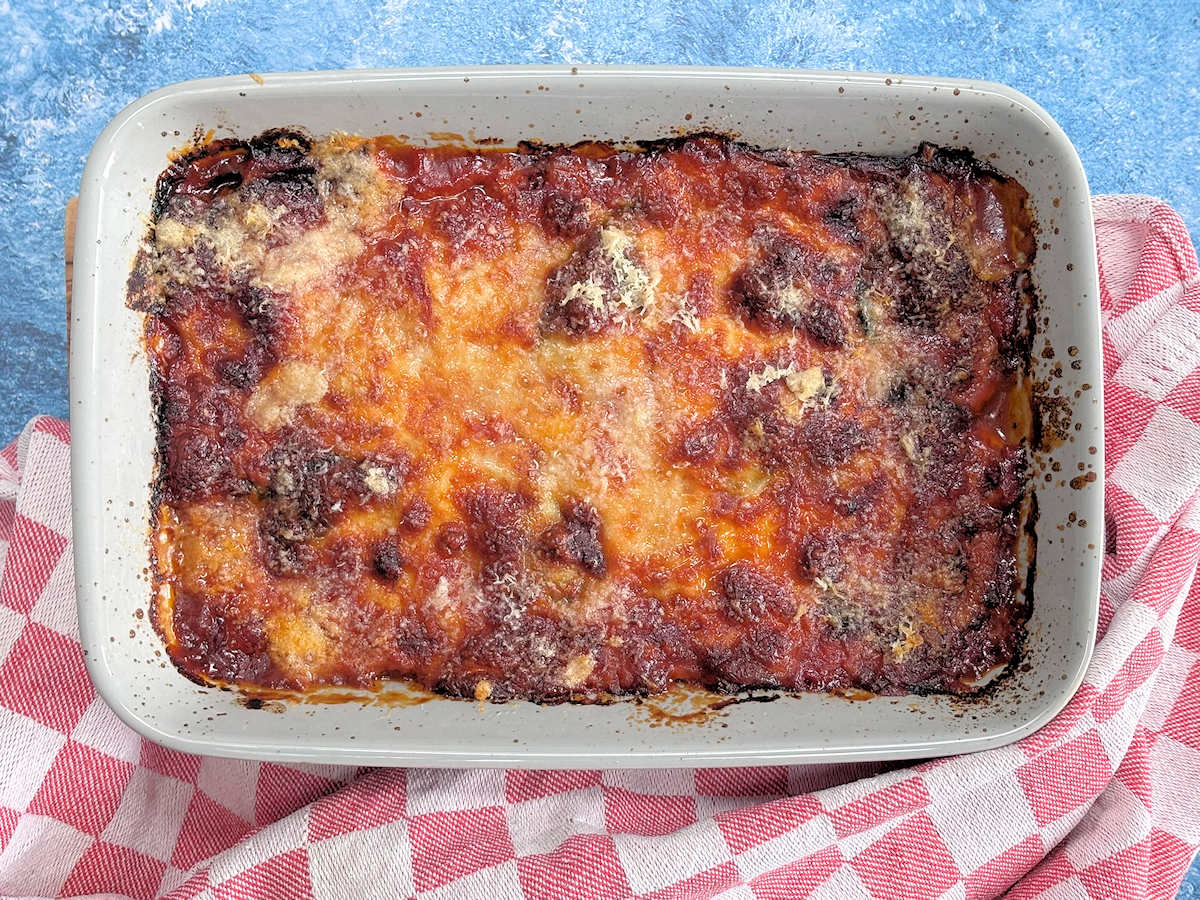Aubergine parmigiana or in Italian parmigiana di melanzane is a bake of layered aubergines, cheese and tomato sauce. It is my all-time favourite vegetarian dish.

Parmigiana di melanzane and nothing else
If someone ever wanted to try and convince me to become vegetarian, they would need to feed me copious quantities of perfectly executed parmigiana di melanzane.
It is the best vegetarian dish in the world. Even though I occasionally try to smuggle bits of meat into otherwise classically veggie recipes, I wouldn’t dare do it with parmigiana.
It doesn’t need meat and will in my view be spoiled for it. Even if you thought replacing plain tomato sauce with nice ragù was a stroke of genius, as some Italian chefs seem to think, it isn’t. It’s a rubbish idea.
Where does the name of parmigiana come from?
You might think ‘parmigiana’ owes its name to the inclusion of Parmesan in the recipe or that it comes from Parma in northern Italy. It is most probably not at all the case as the dish originated in Sicily, imported through Arab traders from Turkish moussaka.
Its name is derived from Sicilian ‘palmigiana’ or ‘parmiciana’ meaning ‘shutters’ and referring to how the aubergine slices are laid in the dish overlapping each other, like the shutters’ slats.
And the linguistic purists will point out that in Italian it is always ‘parmigiana di melanzane (aubergine)’ and never melanzane alla parmigiana.
‘Alla’ is followed by an adjective meaning ‘in the style of’ – e.g. chicken alla Fiorentina. ‘Parmigiana’ on the other hand is a noun and the name of the dish, and thus parmigiana di melanzane is parmigiana of aubergine.
All the other parmigianas
Like a myriad other dishes, once parmigiana crossed the Atlantic, all hell broke loose. Not only did they start swapping aubergine for meat, from chicken to veal and pork, but they’ve mutated the name to ‘parmesan’ as in ‘chicken parmesan’ or shortened to ‘parm’.
Each to their own, and I won’t say no to a nicely prepared bake of chicken or pork cutlets layered with cheese and tomato, but it’s a long, long way from parmigiana di melanzane. Or eggplant parm as they call it. (*eye roll*)
How to prepare aubergines
Aubergines, like mushrooms, deliver a near-meat experience with their robust texture, bite and chew. But they need to be completely soft so cooking the slices beforehand is a must. Some recipes tell you to coat them in flour but I think it’s redundant.
The belief that aubergine needs salting before cooking to expunge bitterness is obsolete – these days they are not bitter.
Salting however improves the texture and stops them from absorbing too much oil, which they sponge up like crazy. So if you have the time, slice the aubergines 1cm/ ½ inch thick and sprinkle with salt. After half an hour or so, wipe them dry with paper towels.
Traditionally perhaps aubergines are sliced across, into rounds. But if you cut them lengthwise, not only more will fit for a batch in the frying pan, but they will ‘slat’ in a dish neater. It’s purely the matter of preference though.
For the traditional parmigiana, aubergine slices should be fried. You can indeed roast them in the oven if frying worries you, but I’m afraid the flavour or texture won’t be perfect. The slices need to be cooked right through, browned and lightly charred on the outside so it’s best to do it in a frying pan or two, in batches.
The best tomato sauce is simple to cook
Good passata or chopped, tinned tomatoes and good seasoning – that’s all you need. The sauce will happily cook while you fry all those batches of aubergines.
Garlic slices sweat for a few seconds in olive oil, then the tomatoes and all the other ingredients are added and simmered energetically for forty minutes or so until thickened. Red splatter is the only downside so cover it with a lid and adjust the heat every now and then.
Assembling parmigiana
Once those two elements (sauce and aubergines) are ready, it’s easy. A thin spread of sauce goes at the bottom of the dish followed by overlapping aubergine slices – it’s supposed to resemble louvre shutters, remember?
A layer of mozzarella and basil comes next, then more sauce. Repeat with as many layers as you have ingredients (two is fine though), ending with sauce and mozzarella plus a showering of Parmesan.
Thus prepared, parmigiana can be kept in the fridge up to overnight, though aubergines might become a little soggy and their texture will suffer.
Parmigiana takes about forty minutes to bake, until the cheese is melted and scorched, the sauce bubbles and the dish looks completely beautiful. It should be served after a little rest though. It won’t taste as good as it should if scalding hot.
More aubergine recipes
Baked ziti, penne or rigatoni with bacon and roasted aubergine: it does not drown in cheese or tomato sauce, and it is not a million calories like your usual pasta bake.
Hot and spicy fried aubergine, a simple side or starter. Aubergine slices are dusted with flour to stop it guzzling oil so much and make the dish healthier.
Classic Greek moussaka with potato slices and minced lamb and beef meat sauce. Moussaka layers are potatoes, aubergines, meat sauce and the topping of thick béchamel. It’s a fantastic dish easy to make in large quantities.
More Italian vegetarian recipes
Chunky vegetable lasagne with peppers, courgettes and tomatoes. Coated with creamy white sauce with mozzarella layers, it will cook to a bubbling, gorgeous perfection.
Mushroom risotto made with dried, rehydrated porcini and masses of Parmesan and butter is a royal feast. I love it just with a green salad.
Tomato crostata with honey and thyme flavour on flaky pastry made from scratch, with a sneaky cheese addition. Crostata or galette is a sweet or savoury open, rustic pie.